Organizational Behavior: An Analysis of Toyota's Reward System
VerifiedAdded on 2022/02/24
|5
|1659
|28
Report
AI Summary
This report examines Toyota's reward plan, delving into its organizational behavior principles. It outlines the components of Toyota's reward system, including both extrinsic and intrinsic rewards, and how these are communicated and implemented within the company. The report explores the purpose of each reward type, analyzing how they align with modern management theory. Recommendations are provided to enhance the effectiveness of Toyota's reward plans, focusing on employee involvement and fairness. Additionally, the report addresses the Wilson Bros case scenario, emphasizing the importance of equal pay and fair evaluation processes. The analysis incorporates relevant academic references to support the findings.
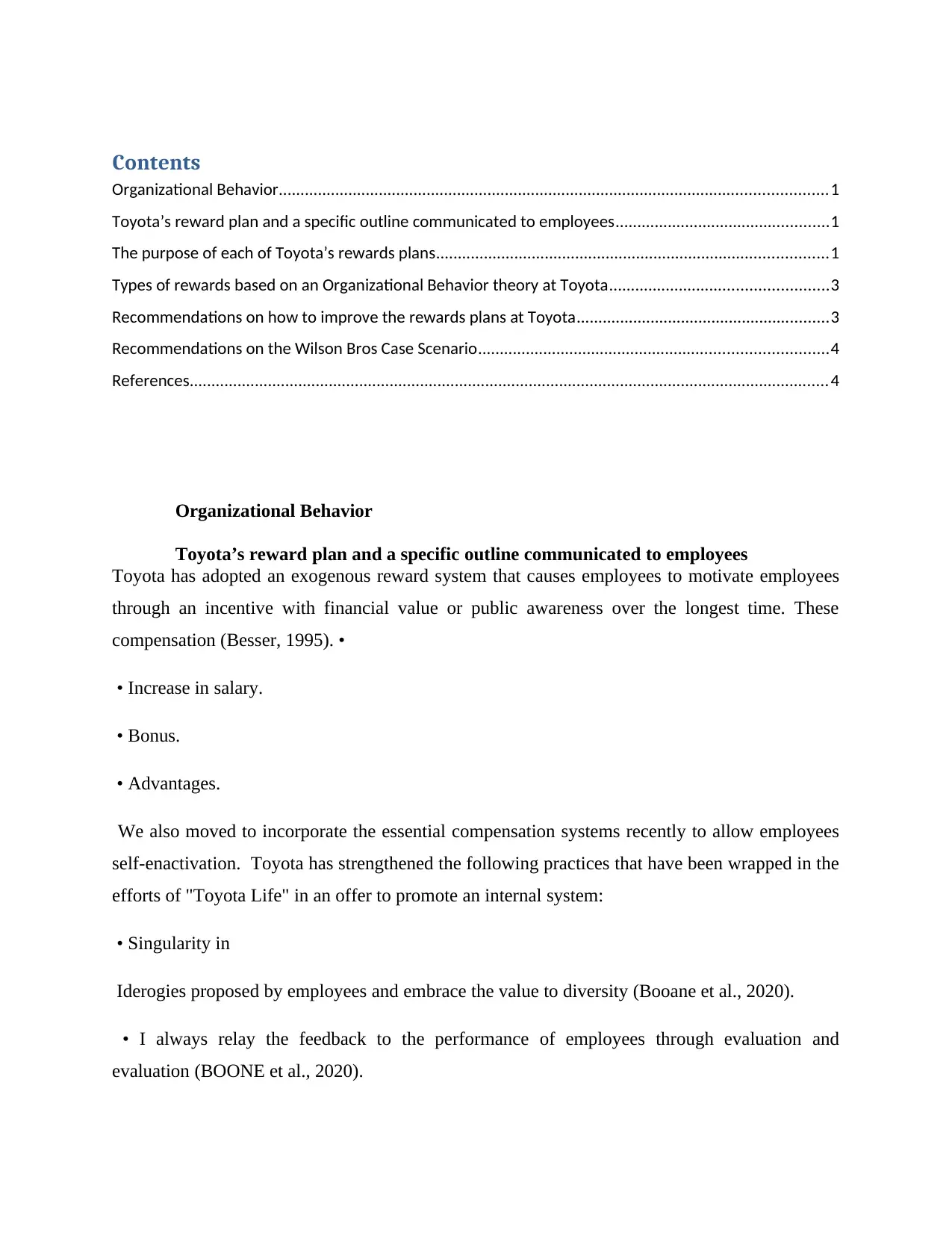
Contents
Organizational Behavior..............................................................................................................................1
Toyota’s reward plan and a specific outline communicated to employees.................................................1
The purpose of each of Toyota’s rewards plans..........................................................................................1
Types of rewards based on an Organizational Behavior theory at Toyota..................................................3
Recommendations on how to improve the rewards plans at Toyota..........................................................3
Recommendations on the Wilson Bros Case Scenario................................................................................4
References...................................................................................................................................................4
Organizational Behavior
Toyota’s reward plan and a specific outline communicated to employees
Toyota has adopted an exogenous reward system that causes employees to motivate employees
through an incentive with financial value or public awareness over the longest time. These
compensation (Besser, 1995). •
• Increase in salary.
• Bonus.
• Advantages.
We also moved to incorporate the essential compensation systems recently to allow employees
self-enactivation. Toyota has strengthened the following practices that have been wrapped in the
efforts of "Toyota Life" in an offer to promote an internal system:
• Singularity in
Iderogies proposed by employees and embrace the value to diversity (Booane et al., 2020).
• I always relay the feedback to the performance of employees through evaluation and
evaluation (BOONE et al., 2020).
Organizational Behavior..............................................................................................................................1
Toyota’s reward plan and a specific outline communicated to employees.................................................1
The purpose of each of Toyota’s rewards plans..........................................................................................1
Types of rewards based on an Organizational Behavior theory at Toyota..................................................3
Recommendations on how to improve the rewards plans at Toyota..........................................................3
Recommendations on the Wilson Bros Case Scenario................................................................................4
References...................................................................................................................................................4
Organizational Behavior
Toyota’s reward plan and a specific outline communicated to employees
Toyota has adopted an exogenous reward system that causes employees to motivate employees
through an incentive with financial value or public awareness over the longest time. These
compensation (Besser, 1995). •
• Increase in salary.
• Bonus.
• Advantages.
We also moved to incorporate the essential compensation systems recently to allow employees
self-enactivation. Toyota has strengthened the following practices that have been wrapped in the
efforts of "Toyota Life" in an offer to promote an internal system:
• Singularity in
Iderogies proposed by employees and embrace the value to diversity (Booane et al., 2020).
• I always relay the feedback to the performance of employees through evaluation and
evaluation (BOONE et al., 2020).
Paraphrase This Document
Need a fresh take? Get an instant paraphrase of this document with our AI Paraphraser
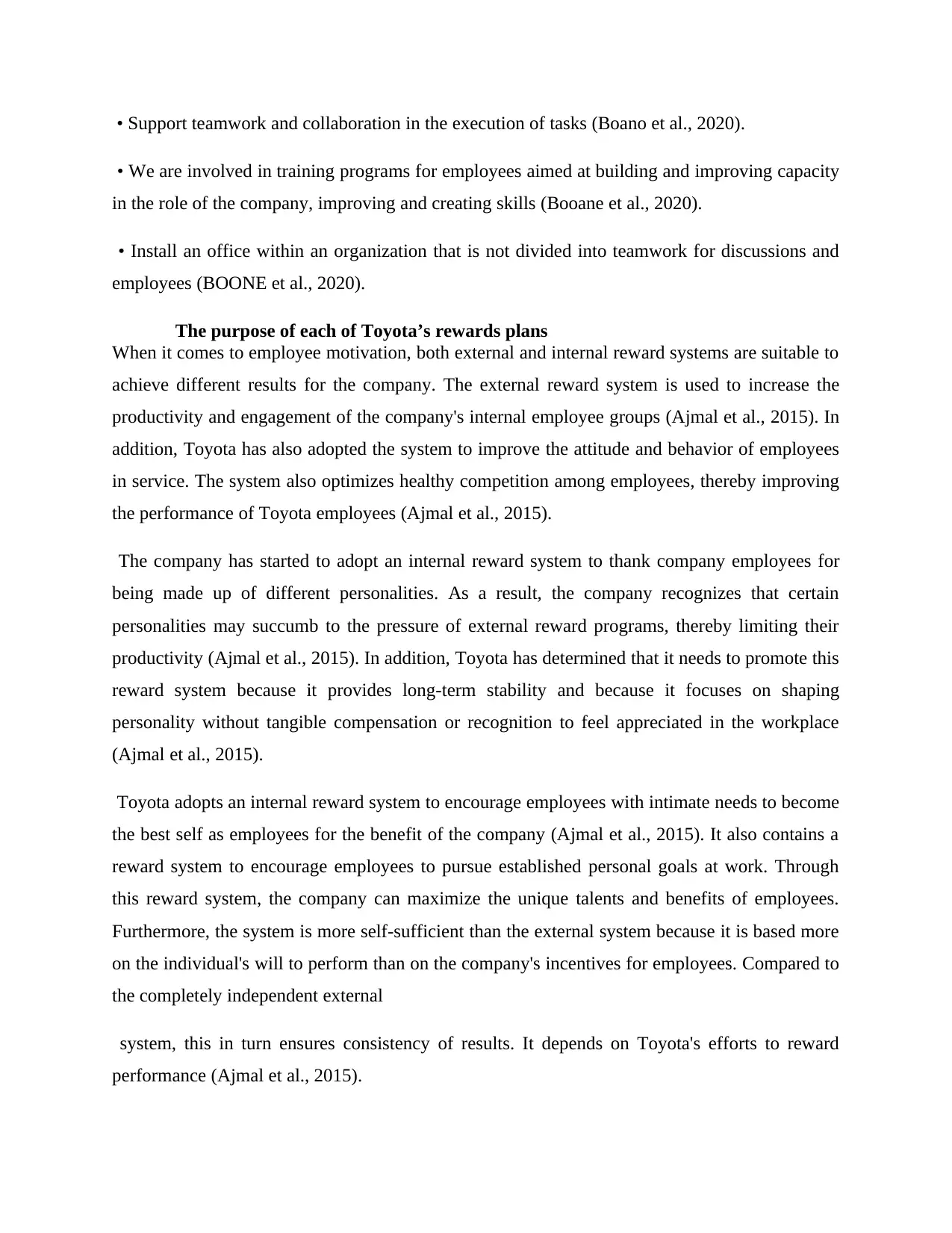
• Support teamwork and collaboration in the execution of tasks (Boano et al., 2020).
• We are involved in training programs for employees aimed at building and improving capacity
in the role of the company, improving and creating skills (Booane et al., 2020).
• Install an office within an organization that is not divided into teamwork for discussions and
employees (BOONE et al., 2020).
The purpose of each of Toyota’s rewards plans
When it comes to employee motivation, both external and internal reward systems are suitable to
achieve different results for the company. The external reward system is used to increase the
productivity and engagement of the company's internal employee groups (Ajmal et al., 2015). In
addition, Toyota has also adopted the system to improve the attitude and behavior of employees
in service. The system also optimizes healthy competition among employees, thereby improving
the performance of Toyota employees (Ajmal et al., 2015).
The company has started to adopt an internal reward system to thank company employees for
being made up of different personalities. As a result, the company recognizes that certain
personalities may succumb to the pressure of external reward programs, thereby limiting their
productivity (Ajmal et al., 2015). In addition, Toyota has determined that it needs to promote this
reward system because it provides long-term stability and because it focuses on shaping
personality without tangible compensation or recognition to feel appreciated in the workplace
(Ajmal et al., 2015).
Toyota adopts an internal reward system to encourage employees with intimate needs to become
the best self as employees for the benefit of the company (Ajmal et al., 2015). It also contains a
reward system to encourage employees to pursue established personal goals at work. Through
this reward system, the company can maximize the unique talents and benefits of employees.
Furthermore, the system is more self-sufficient than the external system because it is based more
on the individual's will to perform than on the company's incentives for employees. Compared to
the completely independent external
system, this in turn ensures consistency of results. It depends on Toyota's efforts to reward
performance (Ajmal et al., 2015).
• We are involved in training programs for employees aimed at building and improving capacity
in the role of the company, improving and creating skills (Booane et al., 2020).
• Install an office within an organization that is not divided into teamwork for discussions and
employees (BOONE et al., 2020).
The purpose of each of Toyota’s rewards plans
When it comes to employee motivation, both external and internal reward systems are suitable to
achieve different results for the company. The external reward system is used to increase the
productivity and engagement of the company's internal employee groups (Ajmal et al., 2015). In
addition, Toyota has also adopted the system to improve the attitude and behavior of employees
in service. The system also optimizes healthy competition among employees, thereby improving
the performance of Toyota employees (Ajmal et al., 2015).
The company has started to adopt an internal reward system to thank company employees for
being made up of different personalities. As a result, the company recognizes that certain
personalities may succumb to the pressure of external reward programs, thereby limiting their
productivity (Ajmal et al., 2015). In addition, Toyota has determined that it needs to promote this
reward system because it provides long-term stability and because it focuses on shaping
personality without tangible compensation or recognition to feel appreciated in the workplace
(Ajmal et al., 2015).
Toyota adopts an internal reward system to encourage employees with intimate needs to become
the best self as employees for the benefit of the company (Ajmal et al., 2015). It also contains a
reward system to encourage employees to pursue established personal goals at work. Through
this reward system, the company can maximize the unique talents and benefits of employees.
Furthermore, the system is more self-sufficient than the external system because it is based more
on the individual's will to perform than on the company's incentives for employees. Compared to
the completely independent external
system, this in turn ensures consistency of results. It depends on Toyota's efforts to reward
performance (Ajmal et al., 2015).
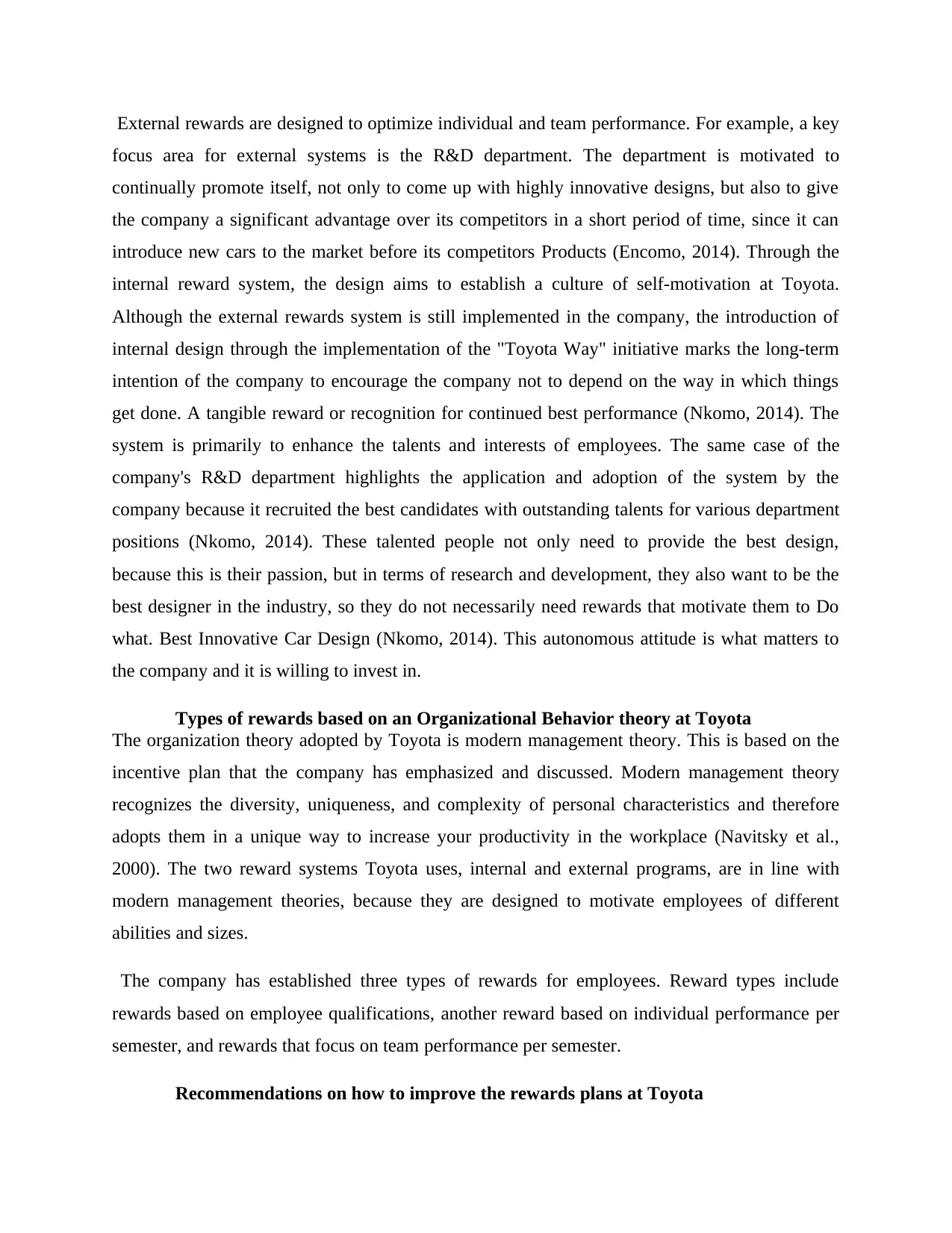
External rewards are designed to optimize individual and team performance. For example, a key
focus area for external systems is the R&D department. The department is motivated to
continually promote itself, not only to come up with highly innovative designs, but also to give
the company a significant advantage over its competitors in a short period of time, since it can
introduce new cars to the market before its competitors Products (Encomo, 2014). Through the
internal reward system, the design aims to establish a culture of self-motivation at Toyota.
Although the external rewards system is still implemented in the company, the introduction of
internal design through the implementation of the "Toyota Way" initiative marks the long-term
intention of the company to encourage the company not to depend on the way in which things
get done. A tangible reward or recognition for continued best performance (Nkomo, 2014). The
system is primarily to enhance the talents and interests of employees. The same case of the
company's R&D department highlights the application and adoption of the system by the
company because it recruited the best candidates with outstanding talents for various department
positions (Nkomo, 2014). These talented people not only need to provide the best design,
because this is their passion, but in terms of research and development, they also want to be the
best designer in the industry, so they do not necessarily need rewards that motivate them to Do
what. Best Innovative Car Design (Nkomo, 2014). This autonomous attitude is what matters to
the company and it is willing to invest in.
Types of rewards based on an Organizational Behavior theory at Toyota
The organization theory adopted by Toyota is modern management theory. This is based on the
incentive plan that the company has emphasized and discussed. Modern management theory
recognizes the diversity, uniqueness, and complexity of personal characteristics and therefore
adopts them in a unique way to increase your productivity in the workplace (Navitsky et al.,
2000). The two reward systems Toyota uses, internal and external programs, are in line with
modern management theories, because they are designed to motivate employees of different
abilities and sizes.
The company has established three types of rewards for employees. Reward types include
rewards based on employee qualifications, another reward based on individual performance per
semester, and rewards that focus on team performance per semester.
Recommendations on how to improve the rewards plans at Toyota
focus area for external systems is the R&D department. The department is motivated to
continually promote itself, not only to come up with highly innovative designs, but also to give
the company a significant advantage over its competitors in a short period of time, since it can
introduce new cars to the market before its competitors Products (Encomo, 2014). Through the
internal reward system, the design aims to establish a culture of self-motivation at Toyota.
Although the external rewards system is still implemented in the company, the introduction of
internal design through the implementation of the "Toyota Way" initiative marks the long-term
intention of the company to encourage the company not to depend on the way in which things
get done. A tangible reward or recognition for continued best performance (Nkomo, 2014). The
system is primarily to enhance the talents and interests of employees. The same case of the
company's R&D department highlights the application and adoption of the system by the
company because it recruited the best candidates with outstanding talents for various department
positions (Nkomo, 2014). These talented people not only need to provide the best design,
because this is their passion, but in terms of research and development, they also want to be the
best designer in the industry, so they do not necessarily need rewards that motivate them to Do
what. Best Innovative Car Design (Nkomo, 2014). This autonomous attitude is what matters to
the company and it is willing to invest in.
Types of rewards based on an Organizational Behavior theory at Toyota
The organization theory adopted by Toyota is modern management theory. This is based on the
incentive plan that the company has emphasized and discussed. Modern management theory
recognizes the diversity, uniqueness, and complexity of personal characteristics and therefore
adopts them in a unique way to increase your productivity in the workplace (Navitsky et al.,
2000). The two reward systems Toyota uses, internal and external programs, are in line with
modern management theories, because they are designed to motivate employees of different
abilities and sizes.
The company has established three types of rewards for employees. Reward types include
rewards based on employee qualifications, another reward based on individual performance per
semester, and rewards that focus on team performance per semester.
Recommendations on how to improve the rewards plans at Toyota
⊘ This is a preview!⊘
Do you want full access?
Subscribe today to unlock all pages.

Trusted by 1+ million students worldwide
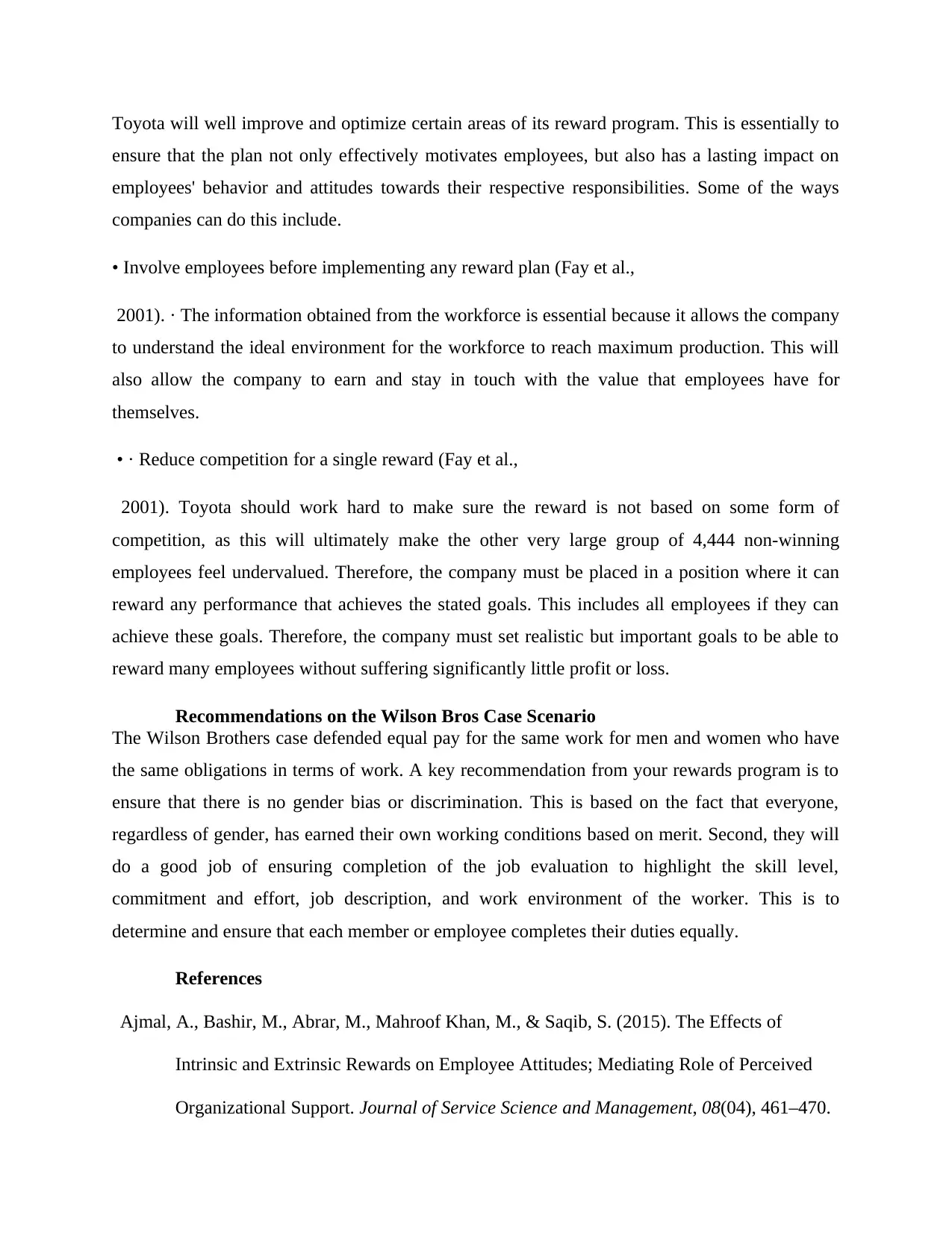
Toyota will well improve and optimize certain areas of its reward program. This is essentially to
ensure that the plan not only effectively motivates employees, but also has a lasting impact on
employees' behavior and attitudes towards their respective responsibilities. Some of the ways
companies can do this include.
• Involve employees before implementing any reward plan (Fay et al.,
2001). · The information obtained from the workforce is essential because it allows the company
to understand the ideal environment for the workforce to reach maximum production. This will
also allow the company to earn and stay in touch with the value that employees have for
themselves.
• · Reduce competition for a single reward (Fay et al.,
2001). Toyota should work hard to make sure the reward is not based on some form of
competition, as this will ultimately make the other very large group of 4,444 non-winning
employees feel undervalued. Therefore, the company must be placed in a position where it can
reward any performance that achieves the stated goals. This includes all employees if they can
achieve these goals. Therefore, the company must set realistic but important goals to be able to
reward many employees without suffering significantly little profit or loss.
Recommendations on the Wilson Bros Case Scenario
The Wilson Brothers case defended equal pay for the same work for men and women who have
the same obligations in terms of work. A key recommendation from your rewards program is to
ensure that there is no gender bias or discrimination. This is based on the fact that everyone,
regardless of gender, has earned their own working conditions based on merit. Second, they will
do a good job of ensuring completion of the job evaluation to highlight the skill level,
commitment and effort, job description, and work environment of the worker. This is to
determine and ensure that each member or employee completes their duties equally.
References
Ajmal, A., Bashir, M., Abrar, M., Mahroof Khan, M., & Saqib, S. (2015). The Effects of
Intrinsic and Extrinsic Rewards on Employee Attitudes; Mediating Role of Perceived
Organizational Support. Journal of Service Science and Management, 08(04), 461–470.
ensure that the plan not only effectively motivates employees, but also has a lasting impact on
employees' behavior and attitudes towards their respective responsibilities. Some of the ways
companies can do this include.
• Involve employees before implementing any reward plan (Fay et al.,
2001). · The information obtained from the workforce is essential because it allows the company
to understand the ideal environment for the workforce to reach maximum production. This will
also allow the company to earn and stay in touch with the value that employees have for
themselves.
• · Reduce competition for a single reward (Fay et al.,
2001). Toyota should work hard to make sure the reward is not based on some form of
competition, as this will ultimately make the other very large group of 4,444 non-winning
employees feel undervalued. Therefore, the company must be placed in a position where it can
reward any performance that achieves the stated goals. This includes all employees if they can
achieve these goals. Therefore, the company must set realistic but important goals to be able to
reward many employees without suffering significantly little profit or loss.
Recommendations on the Wilson Bros Case Scenario
The Wilson Brothers case defended equal pay for the same work for men and women who have
the same obligations in terms of work. A key recommendation from your rewards program is to
ensure that there is no gender bias or discrimination. This is based on the fact that everyone,
regardless of gender, has earned their own working conditions based on merit. Second, they will
do a good job of ensuring completion of the job evaluation to highlight the skill level,
commitment and effort, job description, and work environment of the worker. This is to
determine and ensure that each member or employee completes their duties equally.
References
Ajmal, A., Bashir, M., Abrar, M., Mahroof Khan, M., & Saqib, S. (2015). The Effects of
Intrinsic and Extrinsic Rewards on Employee Attitudes; Mediating Role of Perceived
Organizational Support. Journal of Service Science and Management, 08(04), 461–470.
Paraphrase This Document
Need a fresh take? Get an instant paraphrase of this document with our AI Paraphraser
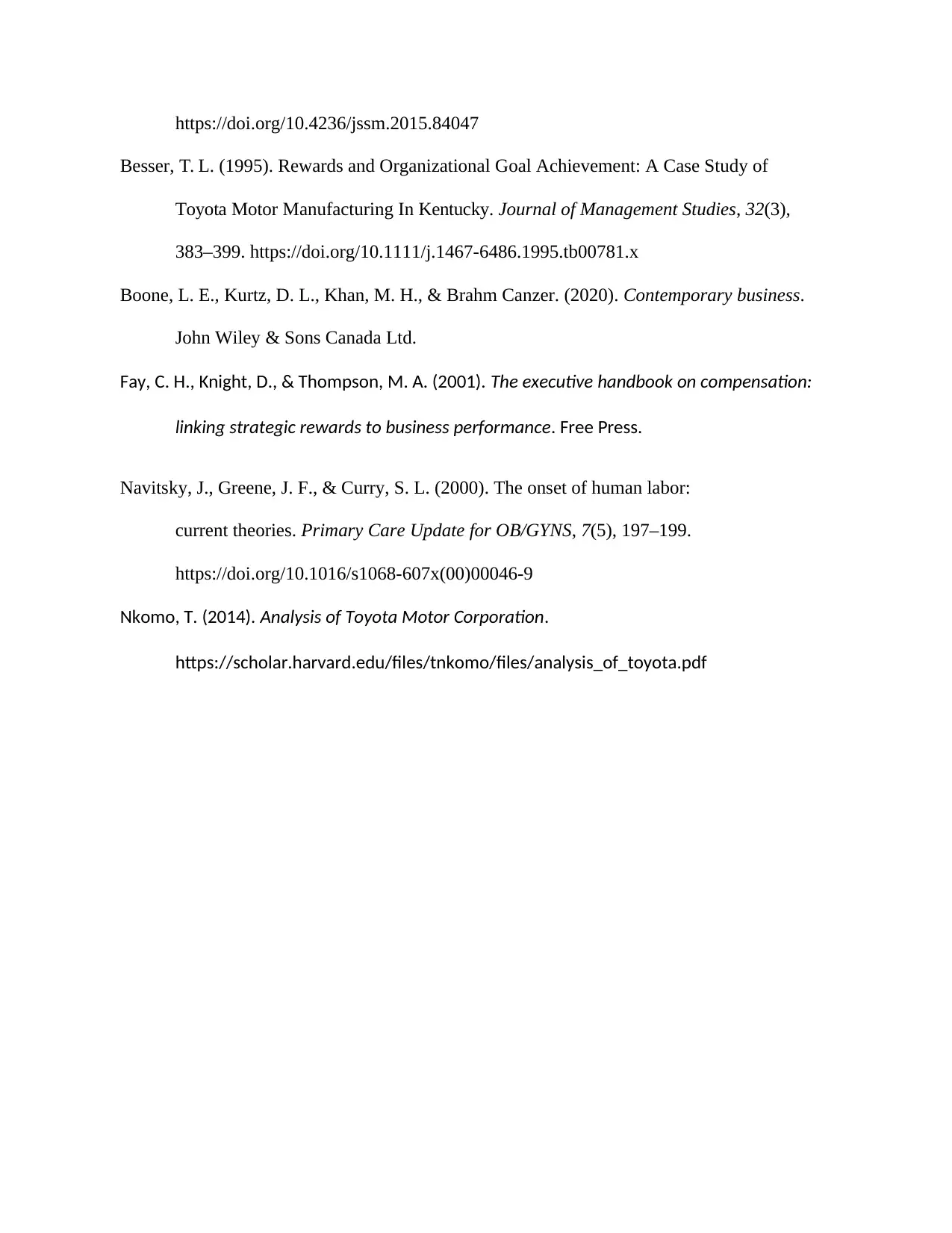
https://doi.org/10.4236/jssm.2015.84047
Besser, T. L. (1995). Rewards and Organizational Goal Achievement: A Case Study of
Toyota Motor Manufacturing In Kentucky. Journal of Management Studies, 32(3),
383–399. https://doi.org/10.1111/j.1467-6486.1995.tb00781.x
Boone, L. E., Kurtz, D. L., Khan, M. H., & Brahm Canzer. (2020). Contemporary business.
John Wiley & Sons Canada Ltd.
Fay, C. H., Knight, D., & Thompson, M. A. (2001). The executive handbook on compensation:
linking strategic rewards to business performance. Free Press.
Navitsky, J., Greene, J. F., & Curry, S. L. (2000). The onset of human labor:
current theories. Primary Care Update for OB/GYNS, 7(5), 197–199.
https://doi.org/10.1016/s1068-607x(00)00046-9
Nkomo, T. (2014). Analysis of Toyota Motor Corporation.
https://scholar.harvard.edu/files/tnkomo/files/analysis_of_toyota.pdf
Besser, T. L. (1995). Rewards and Organizational Goal Achievement: A Case Study of
Toyota Motor Manufacturing In Kentucky. Journal of Management Studies, 32(3),
383–399. https://doi.org/10.1111/j.1467-6486.1995.tb00781.x
Boone, L. E., Kurtz, D. L., Khan, M. H., & Brahm Canzer. (2020). Contemporary business.
John Wiley & Sons Canada Ltd.
Fay, C. H., Knight, D., & Thompson, M. A. (2001). The executive handbook on compensation:
linking strategic rewards to business performance. Free Press.
Navitsky, J., Greene, J. F., & Curry, S. L. (2000). The onset of human labor:
current theories. Primary Care Update for OB/GYNS, 7(5), 197–199.
https://doi.org/10.1016/s1068-607x(00)00046-9
Nkomo, T. (2014). Analysis of Toyota Motor Corporation.
https://scholar.harvard.edu/files/tnkomo/files/analysis_of_toyota.pdf
1 out of 5
Related Documents
Your All-in-One AI-Powered Toolkit for Academic Success.
+13062052269
info@desklib.com
Available 24*7 on WhatsApp / Email
![[object Object]](/_next/static/media/star-bottom.7253800d.svg)
Unlock your academic potential
Copyright © 2020–2025 A2Z Services. All Rights Reserved. Developed and managed by ZUCOL.





